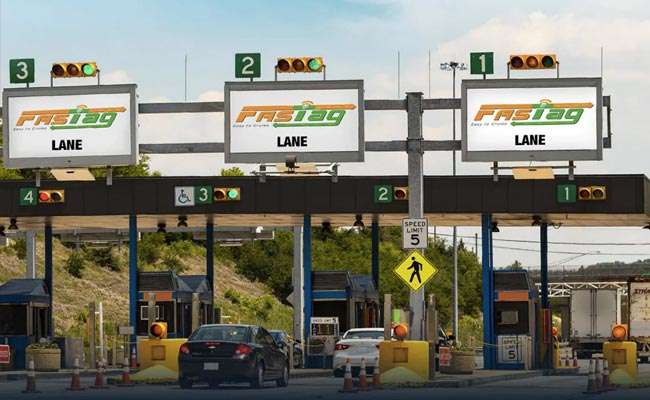ETC Program further aims to serve as open platform for development of services like congestion or cordon pricing, collection of parking fees, automated collection of fines/challans by police authorities, payment of road tax and other duties and plethora of other services.
Nation-wide interoperable ETC program entails setting up of Central Clearing House (CCH) for clearing and settlement of toll transactions, and installation of ETC systems at the toll plazas.
Understanding of Electronic Toll Collection
Conceptually, ETC works by determining whether the vehicles passing through toll collection points are enrolled in the program, alerts enforcers for those that are not, and electronically debits the accounts of registered vehicles without requiring them to stop.
When the vehicle enrolls with an ETC program an On-Board Unit, which contains information about that particular vehicle, is mounted on the vehicle. The Road-Side Units at toll collection points communicate with On-Board Units to extract vehicle information, which is then further used to process toll transactions.
In India, tolling on National Highways started in a big way with the National Highways Development Project (NHDP) launched by the Government in the year 2000. As on date, nearly 220 Toll Plazas are operational on National Highways and more sections are being added at regular intervals. Apart from National Highways, many State Highways and other road projects are developed and operated as toll roads.
Currently, the toll operations in India are mainly manual whereby the receipt and collection of money is done manually and the toll receipts are issued with the help of computers.
Tolling has come to be associated with delays at collection points and congestion at toll plazas mostly due to efficiency constraints associated with manual method of toll collection in practice. The delays negatively impact the operational efficiency of the improved road network and thus neutralize the benefits of the improvement of highway infrastructure.
To overcome these challenges, Government of India has therefore decided to introduce Electronic Toll Collection in India, and thus IHMCL was incorporated to execute this ambitious project.
In a country like India where road stretches are operated and tolled by multiple agencies and authorities, imagine a scenario where different toll collection agencies adopt independent standards and technologies for ETC, and is not linked to ETC programs run by other toll collection agencies. Then a vehicle enrolling with ETC program of one toll operator would not be able to access ETC services offered by other toll operators through same ETC account, that is to say ETC lacks interoperability.In absence of interoperable ETC, the road user will have to register with multiple ETC programs and also have to spend for multiple On-Board Units.
Interoperable ETC offers the convenience of electronically paying toll at any toll collection point through a single ETC account and a single On-Board Unit. Thus interoperable ETC calls for (a) adopting similar technologies and standards for ETC so that same On-Board Unit is acceptable at all toll collection points, and (b) a mechanism for debiting appropriate toll fee from the account of registered vehicle and crediting the same to respective toll collection agency.
The governments and toll collection agencies world over are strugglingto achieve interoperable ETC. Fortunately, in India there are no legacy systems unlike other developed countries and presently ETC is operational at very few toll plazas in stand-alone mode. This provides a distinct advantage in selecting a simple and robust ETC technology which is scalable, reliable, inexpensive to the road users and inter-operable across the country.
Key Highlights
Currently the program is live on 1200+ toll plazas across the country. Please click here to view the complete list.
click here To Check Your NETC FASTag Status
Please click here to view the live banks list.
Benefits of ETC
- Customer can avail cashback of 2.5% on all toll payments using FASTag at all toll plazas along the National Highways and selected state toll plazas (valid for FY 2019-20).
- Near non-stop motion through toll plazas
- Convenience for cashless payment of toll fee
- Less traffic congestion and reduced commute times
- Toll statements which can be mailed or made available online
- Lower operating costs
- Better audit control through centralized user accounts
- Improved capacity without being required to build more infrastructure
- Savings on fuel and reduction of emissions from idling and repeated stops at toll plazas.
- Improves transparency of toll transactions


